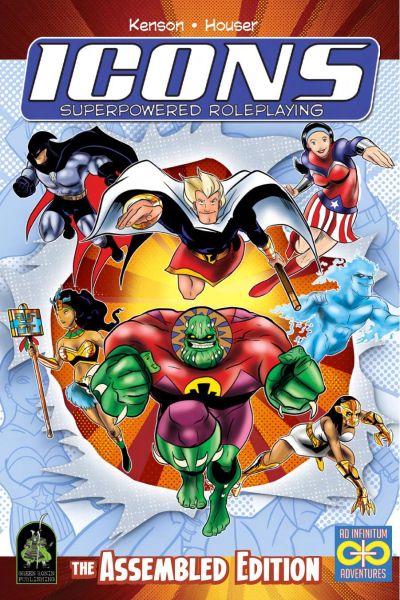My Ten Most Recent Roleplaying Games 3: Icons

26 Apr, 2021
Inspired by Aaron de Orive’s 2020 First Ten RPGs, a brief account of the roleplaying games I have played most recently, beginning with the most recent and working backwards. Number three: Steve Kenson’s Silver Age Superhero RPG Icons.

Icons was first published in 2010. While it shares a designer with Mutants & Masterminds, its approach is very different. Instead of a 320-page rulebook, for example, Icons was a lean 128 pages in the first edition, which expanded to 232 in the assembled edition because RPGs almost never get shorter in successive editions. Where the game stands out against the SHRPGs I usually play is that characters are randomly generated rather than designed1. This has positive and negative consequences.
Icons’ disadvantage is that dice rolls being what they are, one player might roll up a character whose attributes and powers are nigh-godlike, while another player’s character may struggle to be an expendable sidekick (although see Determination Points2). As well, randomly generated characters can be, well, random. It’s up to the player to work out what sort of character might, for example, be able to control fire, have a prehensile tail, and be able to spin at high speeds.
Icons’ advantages are that Chargen is quick, and the FATE-derived core mechanics are straight-forward3. This makes it ideal for pickup games, although it can also be used for long term campaigns. It will never be as close to my heart as the games on which I fixated decades ago but it’s certainly a decent SHRPG option.
1: There is an option for designing characters but it is clear the intention is for players to randomly generate characters.
2: Each character has a certain number of determination points, that number being 6 minus however many powers the character has. Determination points can be used for a number of purposes and are very useful. Clearly, a character with a lot of powers will have few determination points, whereas someone without many powers will have more. While this address balance in terms of range of abilities, it does nothing to address some poor character with straight 3s trying to keep up with some with straight 10s.
3: Roll two six-sided dice, one of which counts as a negative, one as positive, and add them to the value of the appropriate attribute (one of Prowess, Coordination, Strength, Intellect, Awareness, or Willpower), then compare the result to a target number to determine degree of success or failure.
